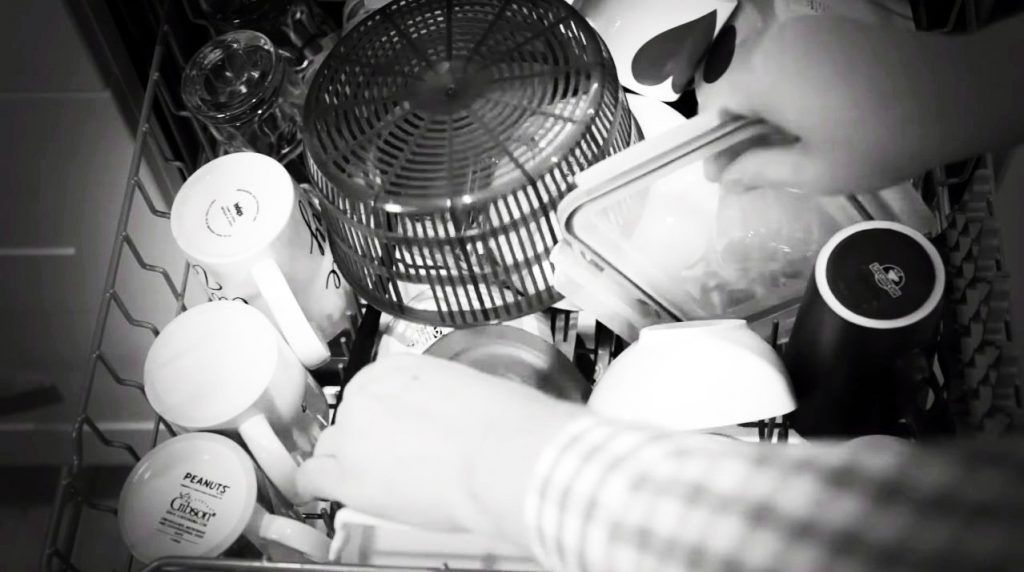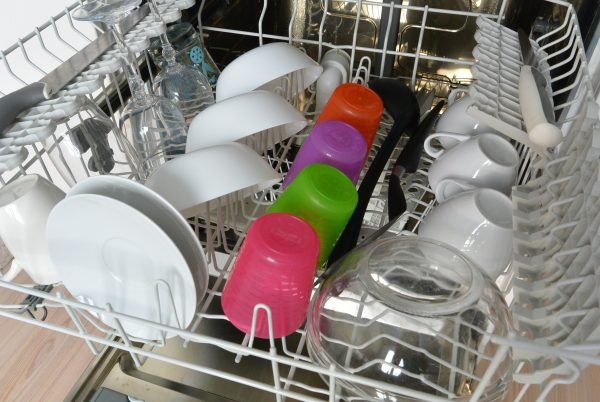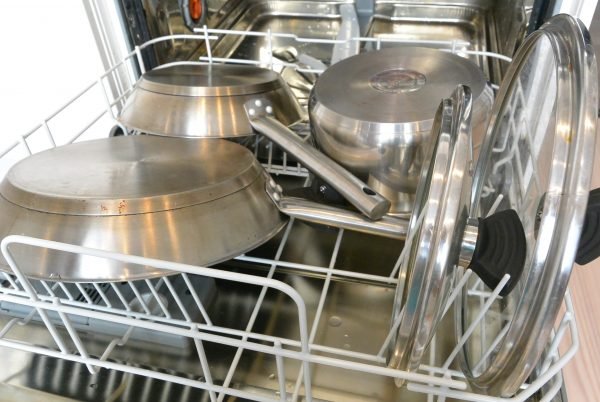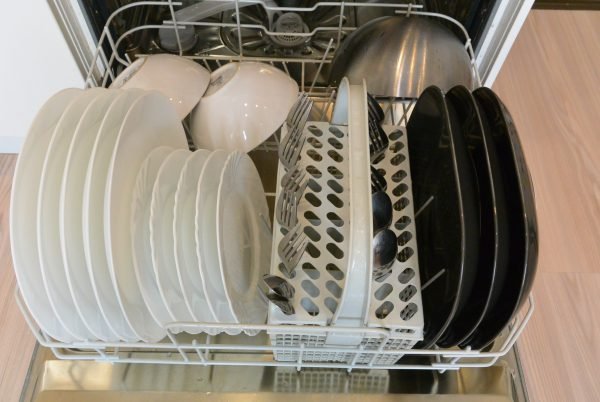Proper loading of your washing machine will significantly improve the washing result; it will also ensure safe and comfortable use. If you follow a common principle of placing dishes, then each time dishwashing will take less time.
How to load a dishwasher
There are general rules for loading any kind of dishes inside the dishwasher:
- all containers should be placed face down, volumetric dishes should be place at a small angle,
- there should be some distance between dishes, they shouldn’t sit close to each other,
- parts of the dishes should not rest touch the body of the machine, hang over or stick out of baskets and trays,
- all dishes should be placed steadily,
- Individual objects should not hinder the rotation of spray arms.
Cups, glasses, wine glasses
All cups and glasses are usually placed in the top basket of the dishwasher. The water pressure in this part is lower and it is good for washing glassware. Cups with convex bottom are placed on the left and right edge of the basket at a slight angle to make the water flow better.
Fragile glassware should be placed separately from oversize items. It should be fixed firmly enough to prevent it from falling because of the water pressure. High glasses should be supported by projections of a grid or by the holders. The side shelf has special holders for the foots of wine glasses.
Cups with artistic patterns, crystal and Bohemian glass can be washed only using special delicate mode with a mild detergent. Memorable and valuable items are better to be left for a hand wash.
Plates and bowls
Large and medium sized plates should be put in the bottom shelf between special pins – baked-on food face down. The biggest items are placed at the sides, medium and small items come afterwards. There must be a gap between the plates, so that the water can wash the whole surface.
Soup bowls are placed in the bottom or top baskets, preferably at a slight angle. In most dishwashing models the dish holders can be folded to free up some extra space in the bottom shelf.
Silverware
Silverware is put into a vertical silverware basket or in a built-in horizontal tray. In the vertical tray, the items are placed handles facing down so that there is as much space as possible between them. The only exception is table knives – they are put with their handles up with the blades at the bottom.
Sharp cutting knives are washed strictly horizontally – they are put into the side shelf of the upper compartment with projections for blades. Ladles, skimmers and other kitchen appliances are also put horizontally in order to prevent them from falling down during washing.
In modern models, all appliances are washed in a convenient drawer located above the top basket.
Pots and frying pans
Larger items for cooking are put in the lower basket. Handles of pots and pans should not interfere with free movement of the basket and should not touch the side walls of the machine.
Kitchen pans are placed at an angle so that they do not interfere with the upper spray arm.
Preparing the dishes
The dishwasher drain system might be clogged like an ordinary kitchen sink if it gets large food remains. Cleaning the drain filters and dishwasher hoses is a time-consuming task, it is better to spend a little time on the preliminary cleaning of the dishes.
Before putting the dishes in the basket it has to be cleaned the following way:
- remove the remnants of food, napkins, toothpicks from plates and bowls,
- clean the inner surface of pots and pans from residue,
- pour off the remaining fat from the pan, wash it under the stream of water,
- use a brush or hard side of the sponge to clean the inside of the pan where the leftovers from the broth are seen,
- pour out the contents of cups, glasses and wine glasses.
You can conveniently clean the dishes with a small stiff brush on a long handle or a spatula with a rubber tip. There is no need to add detergent and rinse all dishes with water.
While the machine handles well with the remains of the sauce or fat, solid food leftovers can damage the drain system. Toothpicks, small bones, corn seeds, and pieces of shells represent the biggest threat.
If you want your dishwasher to work reliably and your dishes to be safe, carefully read the manufacturer’s recommendations. When you buy a new item for your kitchen, pay attention to special labels and inscriptions that allow these items to be washed in the dishwasher.
The washing result will always be excellent if you:
- do not overload the machine and leave a sufficient distance between objects,
- put heavily soiled dishes in the bottom where the pressure of water is stronger,
- put fragile dishes on top and securely fix it,
- select the optimal recommended mode,
- clean the dishwasher with special tools from time to time.
It is not necessary to soak the plates if the dirt hasn’t dried up. If the dishes were left dirty for a long time, they are better to be put in the water for a while – in that case they will be cleaned well. Some models of dishwashers have special “Pre-soaking” mode.
How to load silver accessories
It is recommended not to put old silver kitchen accessories and items in a dishwasher. It causes dark spots, the gloss disappears, and decorative blackening deteriorates. There are modern silver kitchen accessories covered with special protective compound which can be washed in a dishwasher. Such products always have a special labeling.




